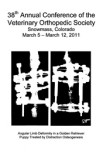OBJECTIVE: To determine outcome and prognostic factors after radius and ulna fracture repair with a modified IMEX miniature circular external skeletal fixation (MCESF) in small and toy breed dogs.
STUDY DESIGN: Retrospective study.
SAMPLE POPULATION: Thirty-seven young small and toy breed dogs with 41 radial and ulnar fractures.
METHODS: Records of radial and ulnar fractures repaired with a modified IMEX MCESF were reviewed. Constructs included 3-4 complete rings, 2 threaded rods, 4 mm-diameter nuts and 6-8 transfixation wires. MCESF configuration, type of fracture reduction, dynamization of the apparatus, inclusion of a dowel pin, and implantation of allograft were recorded. Outcome measures included complications, limb alignment, time to clinical union, and functional outcomes, scored as excellent, good, fair, or poor.
RESULTS: Radiographic union was achieved in 40/41 fractures. Fractures reached bony union within 33-84 days after repair. Time to union was not influenced by the type of fracture reduction (P = .11), use of a dowel pin (P = .099), or implantation of an allograft (P = .45). Fracture dynamization delayed radiographic union (P = .0005). At implant removal, mean frontal (FPA) and mean sagittal plane alignments (SPA) were 7.9° ± 6.5° and 7.5° ± 5.8°, respectively. Limb alignment did not differ between radiographs obtained immediately after surgery and those obtained at time of radiographic union in the frontal (P = .062) or sagittal (P = .14) planes. Ninety-five percent of cases had good-to-excellent outcomes, based on return to function at final re-evaluations.
CONCLUSION: This modified IMEX MCESF construct provided an effective alternative to treat young small and toy breed dogs with radius and ulna fractures.
Radius and ulna fracture repair with the IMEX miniature circular external skeletal fixation system in 37 small and toy breed dogs: A retrospective study
Journal
Bierens D, Unis MD, Cabrera SY, Kass PH, Owen TJ, Mueller MG. Vet Surg. 2017 May; 46 (4): 587-595.









